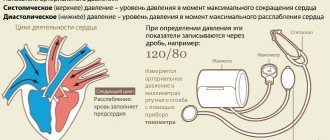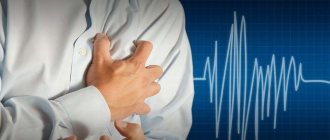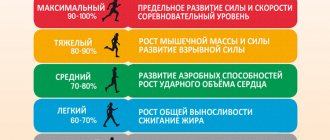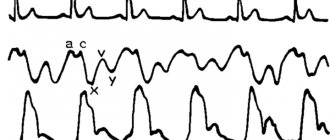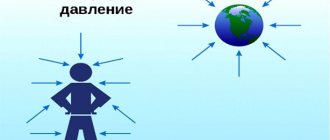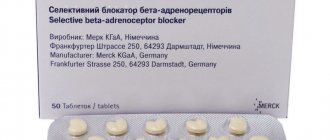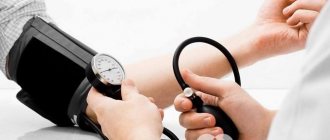Changes in blood pressure occur in adults and children. In adolescence, hormonal levels change, so surges will not be serious deviations. Pressure indicators affect the functioning of the circulatory system. The degree of muscle contraction and the resistance of the vascular walls depend on the arterial values. At the age of 13-17 years, a teenager’s normal blood pressure often changes. Parents need to monitor their child's condition to recognize when surges become a sign of hypertension. If the disease is detected early, good and safe treatment can be selected.
How are blood pressure and heart rate related in children?
Blood pressure and pulse in children are not constant, but are strongly interconnected: if the pressure rises, the pulse rate will be higher than normal, and if the readings drop, the heart rate will decrease. Doctors recommend measuring a child’s pulse only in certain cases, for example, if his face turns blue in the mouth area while crying, the baby quickly gets tired after short games, and drowsiness and lethargy often appear.
In childhood, the pulse rate, and therefore the blood pressure level, is influenced by the following factors:
- sleep disturbance – the child is often capricious for a long time at night, refuses proper daytime rest;
- weather conditions - children react sharply to changes in weather, to sudden rain or snowfall;
- physical activity - children can be hyperactive or completely phlegmatic (calm);
- diet - a lot of fatty, sweet foods, chocolate, coffee, strong tea can cause increased heart rate and increased blood pressure;
- emotional experiences - children are often overjoyed at gifts and events, and are deeply upset about a fall or refusal to buy what they want.
And these are only physiological reasons for fluctuations in blood pressure and pulse rate, but there are also pathological ones - diseases of the kidneys, heart and blood vessels, congenital anomalies in the development of systems/organs, problems in the functioning of the nervous system, mental disorders and others.
That is why doctors do not advise parents to panic if the pulse suddenly increases, which clearly indicates an increase in blood pressure. The diagnosis must be made by a specialist; it is quite possible that this is a natural reaction of the body to an “irritating factor”.
Prevention
If pressure indicators are abnormal, a number of preventive measures must be taken to prevent hypotension or hypertension from developing:
- adhere to proper nutrition;
- prevent overeating and obesity;
- normalize healthy, full sleep;
- monitor physical activity;
- spend more time outdoors;
- Periodically check the condition of the heart and blood vessels with a doctor.
Fluctuations in blood pressure are not uncommon among teenagers. To make sure there is no pathology, you need to see a doctor. He will conduct an examination and determine the true cause of blood pressure deviations in adolescents. If symptoms of the disease are detected, the doctor will prescribe comprehensive treatment in accordance with age.
Blood pressure and pulse in children: norm according to the table
To understand how dangerous fluctuations in blood pressure and pulse are in children, you should refer to the table of norms for these indicators:
| Child's age | Normal upper pressure (systolic in mmHg) | Normal lower pressure (diastolic in mmHg) | Pulse rate (average value, beats per minute) |
| Newborn | 60-80 | 40-50 | 140 |
| First year of life | 90-110 | 55-75 | 130 |
| 12 months-2 years | 100-110 | 60-75 | 124 |
| Up to 4 years | 100-110 | 60-75 | 115 |
| Up to 6 years | 100-115 | 60-75 | 106 |
| 7-8 years | 100-120 | 65-80 | 98 |
| Up to 10 years | 100-125 | 70-80 | 88 |
| Up to 12 years | 110-125 | 70-80 | 80 |
| 13-14 years old | 110-130 | 70-85 | 80 |
| Up to 16 years old | 115-130 | 70-85 | 75 |
When making calculations, you need to take into account that during the day both blood pressure readings and pulse rate can change several times. Therefore, measurements should be taken in the morning, immediately after the child wakes up and preferably before getting out of bed.
How to correctly measure heart rate and blood pressure in children
Heart rate and blood pressure in children are measured only when the child is completely calm, which makes it possible to obtain the most reliable information. It is better to measure blood pressure with standard tonometers, but the pulse is measured using the usual method, by placing your fingers on the inside of your wrist and counting the number of beats per minute.
When calculating the pulse rate, it is necessary to take into account the level of beat uniformity - if it is low, then this may indicate the development of anemia in the child.
In addition to the wrist, there are several other places where you can clearly feel the pulse and count the number of beats:
- armpits - used for measurements in infancy;
- neck, its front part - the carotid artery should be pressed;
- bend of the elbow – to clearly listen to the pulsation in the brachial artery, you need to place your finger directly on the bend of the elbow (from the inside).
You should not count your pulse beats for 10 or 15 seconds and then multiply the result by 6 or 4, respectively - such data will not be entirely accurate. You need to measure the pulse in children within 1 minute, and to get a complete picture of the “behavior” of the cardiovascular system, such measurements need to be taken every morning for a week.
How to measure a child's blood pressure
In order for pressure readings to be correct, you must choose the right device to measure it. There are four options for measuring blood pressure in humans.
Methods for determining blood pressure:
- Palpation method. This technique involves measuring pressure by pressing a finger on the artery and listening to the pulse in it. It is difficult to perform, not very accurate and requires special skills. However, with its help, a specialist can quickly determine blood pressure in an infant.
- Determination of pressure using a tonometer. The simplest and most affordable method that can be easily done at home.
- Dopplerography. This method of checking blood pressure involves the use of ultrasound. It can only be used to determine systolic blood pressure. However, it is the one most often used for newborns.
At home, of course, it is most advisable to use tonometers. At the same time, mechanical, electronic and electromechanical devices are currently popular.
It is easiest to use a mechanical or electromechanical tonometer at home. And it is important for children to choose a device with replaceable cuffs.
It is very important to choose the right cuff for your child. Otherwise, measuring blood pressure will cause discomfort in the baby and give incorrect results.
Thus, the thickness of the cuff in a child under one year old should be three to five centimeters. Then special children's cuffs are used. For teenagers over 14 years old, they buy teenage devices for tonometers.
Normal blood pressure and heart rate in children when playing sports
Measurements during sports will help you understand how much blood pressure and heart rate in children are within normal limits. It is recommended to measure your heart rate before the start of training and immediately after; you must pay attention to the speed of recovery of the heart rate after the end of physical activity.
As soon as the child reaches the age of 10-12 years, you can focus on the norm obtained using the formula “220-n”, where the Latin letter means a specific age.
Therefore, even a heart rate of 200-210 beats per minute after sports activities will be considered normal. Along with this increased heart rate, there may be excessive sweating, shortness of breath/excessive breathing, and flushing of the face (this is a sign of increased blood pressure).
If the number of pulse beats is restored 10-15 minutes after the end of the workout, this will mean that the load level has been chosen absolutely correctly. If the heart rate returns to normal after 20-30 minutes, then the sports instructor should reduce the load on the child.
Factors affecting blood pressure readings
The indicators determine the speed of blood flow. The supply of oxygen to internal organs and tissues depends on blood flow. Arterial values are influenced by:
- age - indicators increase every year, and in teenagers sharp jumps are most often observed;
- gender - adolescent boys have lower values than girls of the same age;
- obesity - the higher the deviation from the norm in weight, the more the pressure jumps;
- bad habits - smoking, alcohol abuse, unhealthy diet, irregular sleep lead to disorders;
- sports - excessive physical activity leads to deviations in indicators up or down.
Various factors can influence blood pressure
A child has high blood pressure and pulse: where to look for the reasons
If a child has high blood pressure and a rapid pulse, then the causes of this condition are most often pathologies:
- problems during metabolic processes (metabolism);
- kidney diseases of an inflammatory, infectious nature;
- dysfunction of the spinal cord and/or brain.
In childhood, an increase in blood pressure and heart rate is often physiological in nature - the child ran too much, played actively, cried for a long time, ate a lot of chocolates, drinks strong coffee, and so on. But in such cases, the child’s condition quickly normalizes, but persistent hypertension will be manifested by tinnitus, decreased visual acuity (floaters, veils, dark spots), severe headache, and nausea.
Causes of the disease
The causes of high blood pressure in adolescents are still being studied! It is generally accepted that hypertension can manifest itself in a primary or secondary form. In case of primary pathology, a hereditary predisposition to high blood pressure increases the risk of developing a malignant disease under the influence of external factors.
Among these risk factors are:
- excess weight;
- increased physical activity;
- frequent emotional stress, stress;
- chronic fatigue, lack of sleep;
- taking medications that increase blood pressure;
- smoking and drinking alcohol.
In the secondary type, hypertension is a symptom. The main disease may be:
- kidney and liver diseases;
- diseases of the endocrine system;
- Congenital heart defect;
- neurotic disorders.
A specific cause of high blood pressure during adolescence is hormonal changes in the body.
Puberty is accompanied by multiple changes in the body. Accelerating body growth creates an imbalance in the development of the body and provokes surges in blood pressure. There is also a connection with vegetative-vascular dysfunction, characteristic of a growing organism.
If your child has low blood pressure and a high pulse
Low blood pressure combined with high blood pressure in a child may indicate:
- blood loss - bleeding can also be internal, due to injuries, so this point needs to be clarified in a conversation with the child;
- dehydration - for example, if the baby has previously vomited or complains of frequent diarrhea;
- development of anemia – children are more often diagnosed with iron deficiency due to too rapid growth/development.
Additional symptoms of this condition will be:
- pronounced pallor of the skin of the face;
- excessive sweating;
- shortness of breath, deep and uneven breathing;
- mild tremor of the upper extremities.
The combination of low blood pressure and high pulse in a child should be examined by a doctor, because it is not considered normal and in most cases signals serious problems in the functionality of the body.
Diagnostics
To identify pathologies leading to changes in blood pressure, the doctor must have accurate information about the indicators. To do this, it is recommended to monitor blood pressure three times a day for several days. Then the doctor conducts a survey of the mother and child, during which he finds out the nature of the complaints, the course of pregnancy, the due date, and possible family heredity.
In addition, additional research will be required. The child is given directions to:
- fundus examination;
- electrocardiogram;
- rheoencephalography of the brain;
- general and biochemical blood tests;
- venous blood analysis for hormones;
- consultations with a cardiologist, neurologist, endocrinologist and other specialists if necessary.
In more complex cases, ultrasound of the heart and other internal organs, computed tomography of the brain and other studies as indicated may be required.
How to normalize indicators
You can normalize your child’s blood pressure and heart rate by following the following recommendations:
- give the body regular physical activity;
- stabilize sleep and strictly adhere to the daily routine;
- adjust your diet by enriching the menu with light and at the same time high-calorie foods, vegetables and fruits;
- take daily walks in the fresh air;
- protect the child from stress or reduce its impact on the psycho-emotional background (the help of a psychotherapist may be needed);
- reduce mental load - for example, it is better for schoolchildren to refuse extracurricular activities.
Swimming and a massage course, which is carried out 2 times a year, help bring blood pressure and heart rate back to normal.
Drugs
Drug therapy is prescribed to children only by a doctor and after identifying the true cause of problems with pulse and blood pressure, since the underlying disease needs to be treated. But as symptomatic therapy they use:
- Seduxen, Valerian and other drugs with a sedative effect;
- Inderal, Obzidan - a group of adrenergic blockers that are used for hypertension.
Physiotherapy
Physiotherapy often helps solve the problem of rapid pulse and uneven blood pressure, so parents should do morning exercises with the child, give him mint tea (no more than 150 ml per day), carry out hardening procedures, and actively play with him in the fresh air.
The pulse rate and blood pressure level in a child must be regularly monitored, because their increase/increase or, conversely, decrease/decrease can be the primary signs of the development of serious pathologies of cardiovascular diseases and kidney pathologies. To understand the true clinical picture, measurements are taken every morning for 7 days, and the results are given to the doctor for analysis.
Deviations from the norm, their causes and treatment
As mentioned above, anything can cause changes in pressure readings. If your baby has arterial hypertension, then you need to know that it can be primary and secondary. Primary usually develops against the background of external factors: emotional, physical overload, and other phenomena affecting the child’s condition. However, after the body has rested, the pressure readings again meet the standards.
With secondary hypertension, deviations can persist for up to several days, which indicates the presence of various diseases. These may be pathologies of the kidneys, heart, obesity, problems with the endocrine system, anemia, infectious diseases.
Causes of increased pressure
Factors influencing increased blood pressure include excessive physical activity, various stresses, and heredity. Poor nutrition can also contribute to changes in indicators: overeating, irregular meals or too little diet, as well as a diet containing high amounts of sodium (salt). Severe overheating of the body quite often leads to an increase in blood pressure.
It is not recommended for a child to increase or decrease blood pressure on his own. Illiterate actions can only lead to complications and aggravate the baby’s condition. If all of the above factors are absent, the child is at rest, and elevated readings persist for several hours or even days, you need to consult a doctor to identify the problem.
If the cause of high blood pressure was hormonal changes in the body during adolescence, then this is not scary and over time everything will return to normal. But if pathologies are found in the body that lead to surges in blood pressure, then competent treatment will be required, and amateur activity in this case can even be dangerous for the child’s life.
Treatment of high blood pressure in children
Treatment of high blood pressure in a child begins if a disease leading to such deviations has been diagnosed. Symptomatic therapy in this case does not provide a long-term effect. If the cause is vegetative-vascular dystonia or intracranial hypertension, then the child requires sedative therapy. It is possible to prescribe "Elenium", "Seduxen". It will also be necessary to normalize the regime. It is necessary to set aside time for daily walks in the fresh air, as well as physical therapy. It is possible to involve your child in various sports, but so that the load increases gradually.
If the increase in pressure is isolated - not associated with any pathologies, then treatment with beta-blockers will be required. Inderal and Obzidan are often prescribed. It is also possible to use Reserpine or Rauvazan for the treatment of high blood pressure. The dosage of the drug is selected separately in each specific case. It depends on the condition of the child and the readings on the tonometer. It is possible to prescribe diuretic drugs: “Hypothiazide”, “Veroshpiron”.
Causes of hypotension
If a child's blood pressure drops below 100/60, then they speak of the development of hypotension (arterial hypotension). A special risk group in this case are schoolchildren. Most often, this condition is diagnosed in girls. However, deviations of blood pressure from the norm to a lesser extent can also be observed in newborns. This is often associated with intrauterine development disorders, various infections or premature birth.
Doctors consider the most common causes of low blood pressure to be:
- hereditary predisposition, the probability of developing hypotension in this case can reach 80%;
- congenital anatomical abnormalities, birth injuries, improper and untimely overgrowth of the fontanel;
- hormonal changes during puberty;
- frequent psycho-emotional shocks, excessive study loads;
- chronic diseases of the respiratory system and ENT organs;
- low physical activity;
- diets, poor nutrition, vitamin deficiency.
Hypotension can be caused by various diseases and traumatic factors. These include:
- metabolic disorders;
- pathologies of the endocrine system;
- digestive system problems;
- malfunction of the pituitary gland;
- predisposition to diabetes mellitus or its presence;
- traumatic brain injuries;
- diseases of the cardiovascular system;
- injuries accompanied by blood loss;
- Iron-deficiency anemia;
- kidney disease;
- cerebrovascular accidents.
Treatment of hypotension
Low blood pressure is very often accompanied by a headache and parents, trying to alleviate the baby’s condition, give him analgesics. This is the wrong action, since without a diagnosis, the use of painkillers is contraindicated. These drugs can blur the picture of the course of the disease and complicate the identification of the underlying pathology.
In children under 10 years of age, it is not recommended to correct low blood pressure with medication. To alleviate the baby’s condition and relieve pain, you can offer him to drink a cup of weak coffee (natural) with milk. Hot chocolate and sweet black tea can also increase blood pressure.
From 11-12 years of age, hypotension is treated with special medications prescribed by the doctor. The frequency of administration and dose should also be discussed with the doctor and you absolutely cannot change them yourself. Most often in pediatric practice for the treatment of such conditions the following is used:
- "Gutron";
- "Rantarin";
- "Caffeine";
- "Heptamil";
- "Piracetam";
- "Ekdisten".
Adults often take Citramon for headaches. It should absolutely not be given to children, since in addition to caffeine, the active ingredient in this drug is acetylsalicylic acid. It thins the blood, which can lead to clotting problems. Medicines containing caffeine are not used if the child has low blood pressure accompanied by a rapid pulse.

